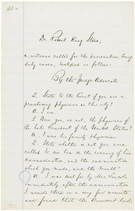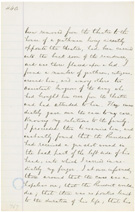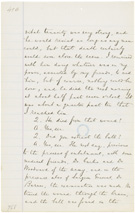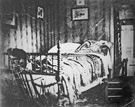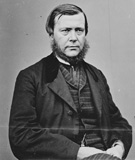Fallen Leaders
Robert King Stone - Assassination of President Abraham Lincoln, 1865
On April 14, 1865, at approximately 10:20 p.m., John Wilkes Booth, a prominent American actor, snuck up behind President Abraham Lincoln as he watched a play at Ford’s Theater, and shot him in the back of the head at point-blank range. The President was carried across the street to a private home where he died early the following morning. Booth, pursued by Union soldiers for twelve days through southern Maryland and Virginia, died of a gunshot wound on April 26 after refusing to surrender to Federal troops.
The murder of President Lincoln was part of a larger conspiracy that included a simultaneous attack on Secretary of State William H. Seward and the possible targeting of Vice President Andrew Johnson. Assuming the Presidency after Lincoln’s death, President Johnson considered the crime a military one, and he ordered that the eight accused conspirators be tried before a military commission. Dr. Robert King Stone, the Lincoln family physician, was one of 350 witnesses who testified during the course of the proceedings. His testimony is shown here.
Statement of Dr. Robert King Stone, President Lincolnís family physician, May 16, 1865, page 43a
The eight accused conspirators were tried before a military tribunal that convened at the old penitentiary on the grounds of the Washington Arsenal, the site presently occupied by Fort McNair. Court reporters took down verbatim the testimony of each witness in shorthand. This document is a transcription of Dr. Stone’s testimony, as recorded by the court reporters.
Of the fourteen doctors who attended President Lincoln on the night of his assassination, Dr. Stone is the only one who presented testimony on the President’s condition.
National Archives, Records of the Office of the Judge Advocate General (Army)
Excerpt:
“I was sent for by Mrs. Lincoln immediately after the assassination. I arrived there in a very few moments. . . . [I] found that the President had been removed from the theatre to the house of a gentleman living directly opposite the theatre, had been carried into the back room of the residence, and was there placed upon a bed. I found a number of gentlemen, citizens, around him. . . .”
—From Dr. Stone’s testimony
.
Statement of Dr. Robert King Stone, President Lincolnís family physician, May 16, 1865, page 44a
The eight accused conspirators were tried before a military tribunal that convened at the old penitentiary on the grounds of the Washington Arsenal, the site presently occupied by Fort McNair. Court reporters took down verbatim the testimony of each witness in shorthand. This document is a transcription of Dr. Stone’s testimony, as recorded by the court reporters.
Of the fourteen doctors who attended President Lincoln on the night of his assassination, Dr. Stone is the only one who presented testimony on the President’s condition.
National Archives, Records of the Office of the Judge Advocate General (Army)
Excerpt:
“I proceeded then to examine him, and instantly found that the President had received a gun shot wound in the back part of the left side of his head, into which I carried immediately my finger. I at once informed those around that the case was a hopeless one; that the President would die; that there was no positive limit to the duration of his life, that his vital tenacity was very strong, and he would resist as long as any man could, but that death certainly would soon close the scene.”
—From Dr. Stone’s testimony
.
Statement of Dr. Robert King Stone, President Lincolnís family physician, May 16, 1865, page 45a
The eight accused conspirators were tried before a military tribunal that convened at the old penitentiary on the grounds of the Washington Arsenal, the site presently occupied by Fort McNair. Court reporters took down verbatim the testimony of each witness in shorthand. This document is a transcription of Dr. Stone’s testimony, as recorded by the court reporters.
Of the fourteen doctors who attended President Lincoln on the night of his assassination, Dr. Stone is the only one who presented testimony on the President’s condition.
National Archives, Records of the Office of the Judge Advocate General (Army)
Excerpt:
“I remained with him doing whatever was in my power, assisted by my friends, to aid him, but of course, nothing could be done, and he died the next morning at about halfpast seven o’clock. . . .”
—From Dr. Stone’s testimony
.
Abraham Lincoln, photograph from the Mathew Brady Collection, ca. 1861Ė65
National Archives, Records of the Office of the Chief Signal Officer [111-B-3658]
.
President Lincolnís deathbed, photograph by Julius Ulke, April 15, 1865
Six men carried the President across the street to the back bedroom of a house owned by William Petersen. There the doctors monitored his breathing and vital signs throughout the night. All of the doctors in attendance were convinced that the wound was fatal.
Only Mrs. Lincoln, stunned and inconsolable, clung to hope for his recovery. The President died the following morning at 7:22 a.m.
Julius Ulke, who was a boarder at the house where Lincoln died, took this photograph shortly after the President’s body was removed.
Courtesy of Chicago History Museum [ICHi-11209], Chicago, Illinois
.
Dr. Robert King Stone, photograph from the Mathew Brady Collection, ca. 1861Ė65
National Archives, Records of the Office of the Chief Signal Officer [111-B-5927]
.
